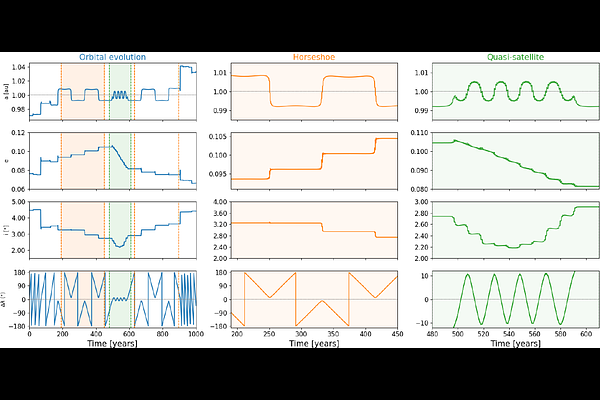The Moon as a possible source for Earth's co-orbital bodies

The Moon as a possible source for Earth's co-orbital bodies
R. Sfair, L. C. Gomes, O. C. Winter, R. A. Moraes, G. Borderes-Motta, C. M. Schäfer
AbstractThere is a growing number of Earth's co-orbital bodies being discovered. At least five of them are known to be temporarily in quasi-satellite orbits. One of those, 469219 Kamo'oalewa, was identified as possibly having the same composition as the Moon. We explore the conditions necessary for lunar ejecta to evolve into Earth's co-orbital bodies, with particular attention to quasi-satellite orbits. We investigate the parameter space of ejection velocity and geographic launch location across the lunar surface. The study employs numerical simulations of the four-body problem (Sun-Earth-Moon-particle) with automated classification for co-orbital states. Particles are ejected from randomly distributed points covering the lunar surface with velocities from 1.0 to 2.6 times the Moon's escape velocity. Trajectories co-orbital to Earth are found to be common, with approximately 6.68% of particles evolving into Earth co-orbital motion and 1.92% exhibiting quasi-satellite behavior. We identify an optimal ejection velocity (1.2v$_{esc}$) for quasi-satellite production, yielding over 6% conversion efficiency. Successful ejections show a strong preference for the equatorial regions of the trailing hemisphere. Collisions with Earth or Moon occur for only 4% of the sample. Extended integrations reveal long-lived configurations, including tadpole orbits persisting for 10,000 years and horseshoe co-orbitals maintaining stability for 5,000 years. Our results strengthen the plausibility of lunar origin for Earth's co-orbital bodies, including quasi-satellites like Kamo'oalewa and 2024PT5. We identify both "prompt" and "delayed" co-orbital formation mechanisms, with a steady-state production regime that could explain the presence of lunar-derived objects in Earth's co-orbital regions despite infrequent major lunar impacts.